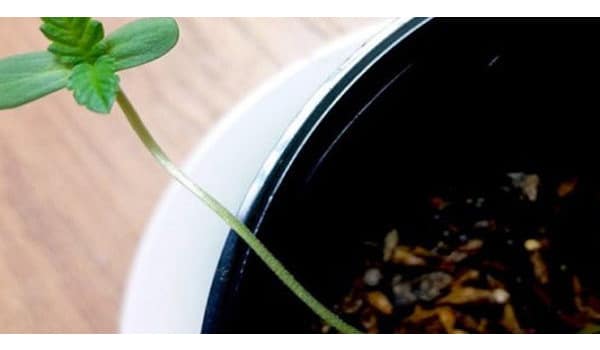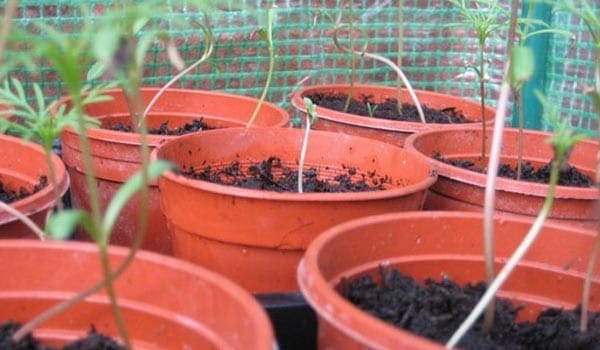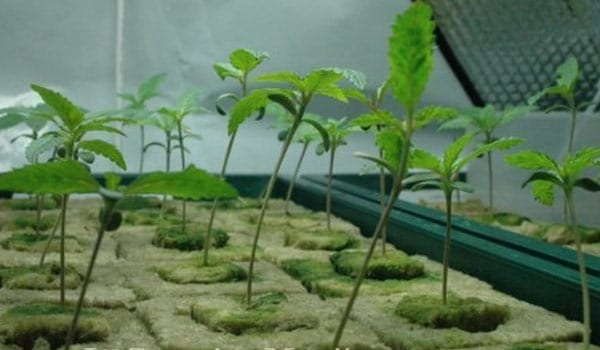
Elongated, stretchy stems are the bane of any new marijuana grower. They don’t provide a stable base for a seedling, which can end up affecting the plant throughout its lifecycle. But, getting rid of the stretchy stem is really a matter of replanting the seedling, so it doesn’t continue to grow disproportionately.
Why do seedlings stretch?
There are several reasons why a marijuana plant may stretch. Sometimes there is nothing you can do to prevent a plant from creating tall stems regardless of your efforts to stop it.

Many factors may cause a marijuana seedling to stretch. Some are biological and others aren’t, however in all cases, the plant grows differently as a result. Here are just a few reasons why a seedling might stretch:
- Lack of nutrients in the soil
- Unstable temperatures
- Improper lighting schedule
There’s also the plant’s genetics. If a marijuana plant’s parents were originally grown indoors or if they promoted the growth of crowding plants, there is a chance that natural selection kept this trait in the seed’s genotype. But if those seeds were made by a ‘’Willy-nilly’’ crossing from hybrid plants, their offspring will be so variable that it will be hard to know what to expect. Keep in mind, some plants just naturally grow taller than others. One example of a strain that grows tall both indoors and outdoors is the tropical, landrace pure Sativa.
Sun-hungry behavior
Marijuana plants love light, but some plants may love it a bit too much. SARP is term used among growers that is short for “shade avoidance response phenotype.’’ This is when a plant stretches to reach light that is being stolen by a neighboring plant.
Did you know that plants are perfectly aware of their surroundings?
A marijuana plant can sense when a neighboring plant is close due to less red in the light that is reflected off. This also means they are less likely to stretch when red spectrum HPS lights are used because they have enough. Of course, temperature and the timing of the growth cycle play a role in the phenomena as well; so, the overall environment is still critical. It can decide if SARP behavior starts to show.
Factors that make your plant more likely to stretch include:
- Space between plants
- High temperatures
- Not enough light
- Distance to the light
It’s important to understand that SARP isn’t solely about access to light. It is a mixture of outside factors that interact with the light quality. The amount of light would not be as much of an issue if the plant did not feel threatened by the presence of another plant. However, when the plant is not exposed to light for a long enough time, it becomes more sensitive to the specific red spectrums needed for growth. When the photoperiod (length of light exposure) is long enough, the spectrum is less relevant.
Stretching, that is not due to shade avoidance, on the other hand, can occur with plants that do not get enough light in terms of intensity. In an indoor setup, it could be that the lamps are too far from the plant. It is literally trying to reach the light. Even though crowding is not the issue, this type of stretching is still a problem because these plants may have a higher risk of premature flowering.
Why stem stretching is an issue
Marijuana plants can develop stretched stems when grown both indoors and outdoors. They may be easy to miss, since a stretched plant may still be large, however, the yield will be much less. Stretched plants are more expensive to grow since those long stems need extra energy – energy that could have gone to growing bigger buds.
Indoors, these decreased yields are likely related to the challenges of creating proper lighting in an indoor grow.
Stretching can also create fragile stems, which means the plant is at risk of falling over. It is also definitely an issue where ceiling height is a concern.
Stretching can be a big problem, but there are ways to prevent it from happening.
Ways to reduce the risk of stretching
Air Circulation
Having good air circulation will allow the stems and leaves to get thicker and stronger while at the same time reducing how high it grows.
Strong air circulation can create stem and leaf movement that strengthens and widens the stem while also slowing its vertical growth. Winds will bend the stem, creating small rips in the plant’s tissue. You can also just brush the leaves to simulate the effects of air circulation.

Lighting
The type of light you use also plays a role in how tall your stems will grow. Orange and red lights provoke taller, thin stems, but thick, short stems blue light is best. Using metal halide lamps while the plant is in the vegetative stage will produce short stems.
Another way to control the height of your plant is by using infrared light. You use these when the lights are off. A black cloth covers the heat lamp reflector, which makes it so the infrared rays create the right results. At the same time, it catches red light to prevent contradicting what you are trying to accomplish. It is best only to use this light during the flowering stage.
The distance of the lights from your plants can also lead to stretching. To avoid stretchy stems make sure your marijuana seedlings get enough light.
In an indoor setup, place your plants under a CFL bulb (3 watts per seedling). The distance between plant and CFL bulb should be around 2 inches. If using HPS bulbs, the distance should be around 40 inches for seedlings (20 inches for vegging plants) but make sure temperatures don’t exceed 77 ºF.
Outdoors, the distance may not be as relevant, but the amount of sunlight will be. Make sure you are growing according to your region’s growing calendar. In some cases, shorter days may cause plants to stretch – regardless of the amount of sun they are getting during the day. Even in the most tropical areas, outdoor plants may need additional nighttime lighting to prevent stretching during some seasons.
Heat and Stem Growth
The temperature influences how your stems grow. The higher the temperature, the longer the stems will grow. Your plant’s stems will widen, and the growth will lessen at about 60*F. When you have it around 80*F, the stems and buds will begin stretching.
If your buds get too close to the light, this causes it to become tall and thin. Don’t make the mistake of thinking this is light burn because this is not the case. In fact, the heat from the lamps can make it unbearable for buds. Air-cooled lamps are great for keeping much of the heat from coming into the room.
Not having the proper amount of light will lead to stem stretching. As a result, the seedlings will grow tall, thin stems because it is trying to access more light. As a solution to this problem, give it a more intense light schedule, or you can place them nearer to the light. Once you have done this, the stems will grow thicker and do much better on their own.
Lastly, try pruning as a way to reduce stem stretching. By cutting off the top of the stem, it makes the rest of the branch grow.
Spacing In-between Plants
Growing your plants in bulk leads stretching. As your plant grows, the leaves may easily start coinciding with the plant next to it. Over time, this causes the bottom of the plant to be discolored, and the sub-canopy will get darker.
Reduce Stress
Stem stretching is the result of many factors, which include high/low temperatures, transplant shock, light spectrums, and humidity. Keep your plant happy by making sure the environment is the best for your plant.
Fixing Stretched Plants
If your plants have already started to stretch there are some ways to fix the problem, if you notice it early enough. If it is during the vegetative state or the first two weeks of the flowering stage, you can use blue lights to reduce it. This simple step could save a bunch of trouble later on.
Keep in mind, stretching isn’t always a bad thing. Some growers like a bit of stretch and feel that is good for avoiding bud rot in certain strains. But in most cases, stem stretching is not desirable.

If you do notice that your plant is stretching, refrain from giving it too much nitrogen. Instead, use a fertilizer ratio of (2-2-2) at the beginning of the flowering stage to keep the nitrogen levels average. Remember to keep it gradual. Making an instant shift to the normal flowering ration right after the vegetative stage causes yellowing.
Also, use oscillating fans if you’re growing indoors. A little bit of movement helps make your stems healthier.
If your plants have already experienced large amounts of stretching, here are two ways to nurse them back to life.
Bury the plant
Giving the plant a stronger base can help it stand up straight while the stems grow back stronger. You can create this base by basically re-potting the plant.
First, you’ll want to make sure the soil is dry. If it’s wet, the roots will have a tendency to cling, and you don’t want them to be damaged in any way. Then, very carefully remove the marijuana seedling from its current container. Clean off the roots so that there is no more soil attached.
You may want to use a deeper container or just dump the soil out from the seedling’s current container. Leave a little bit of soil in the bottom of whatever container you decide to use so that the roots won’t try to grow through the drain holes. Place the seedling down in the container in such a way that you can bury the stem. It is ideal to bury the stem almost completely so that only the Cotyledon leaves are showing. After that, provide the marijuana plant with just a touch of water to get it going again.
At this point, your stem will be buried, and it will eventually start to grow roots of its own. This is something that can apply to little seedlings and even incredibly long, emaciated stems. Again, as long as you’re extremely gentle with the plant, you should cause no harm, and the plant will not be stressed.
Staking
You can also reinforce your plant by using stakes. Various growers have devised methods of staking their plants so that the stems can recover.
You could use some sort of fabric, such as fabric or yarn to create a lattice around weak, stretched stems. This works especially well in a greenhouse where you can simply tie the plants so that they remain standing.
Others use traditional stakes made out of plastic or bamboo and tie or tape weak plants to them for support.
If you decide to use stakes or otherwise tie your plant, be careful not to damage the stem in any way. The idea is to provide support, not stress, otherwise, the stretching will not stop. If you use stakes, it may be a good idea to invest in specialty gels that strengthen the stem during the process.
0 Comment:
Post a Comment